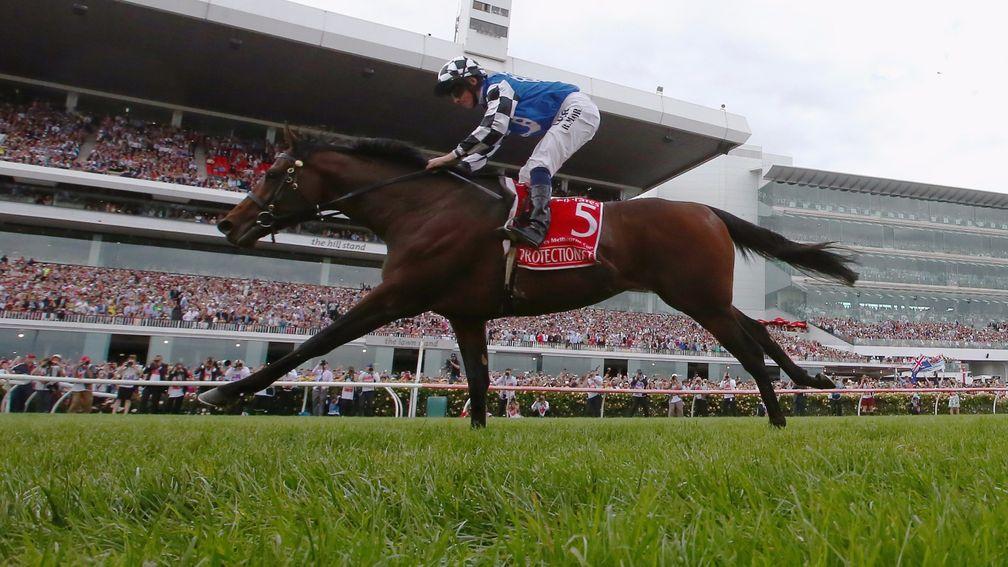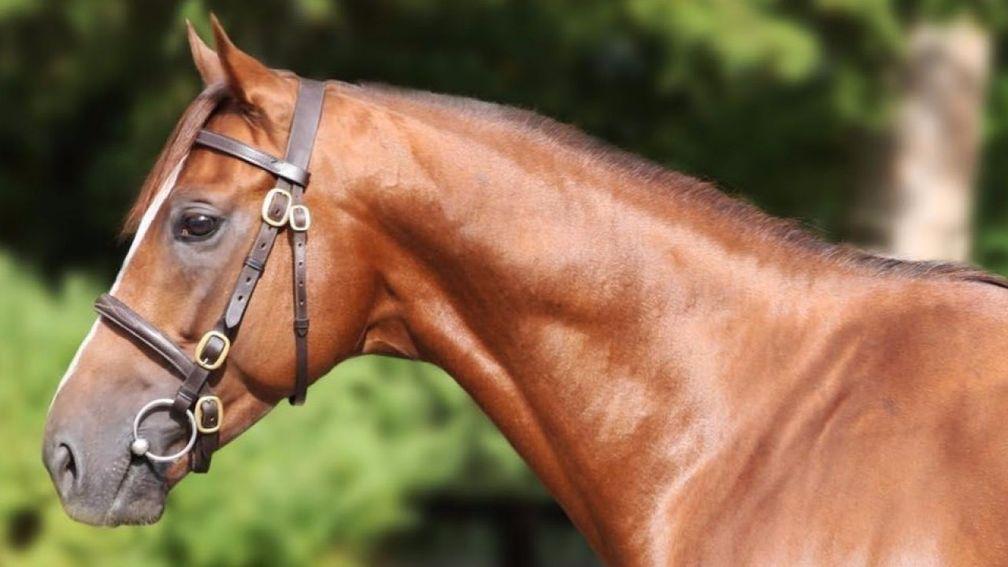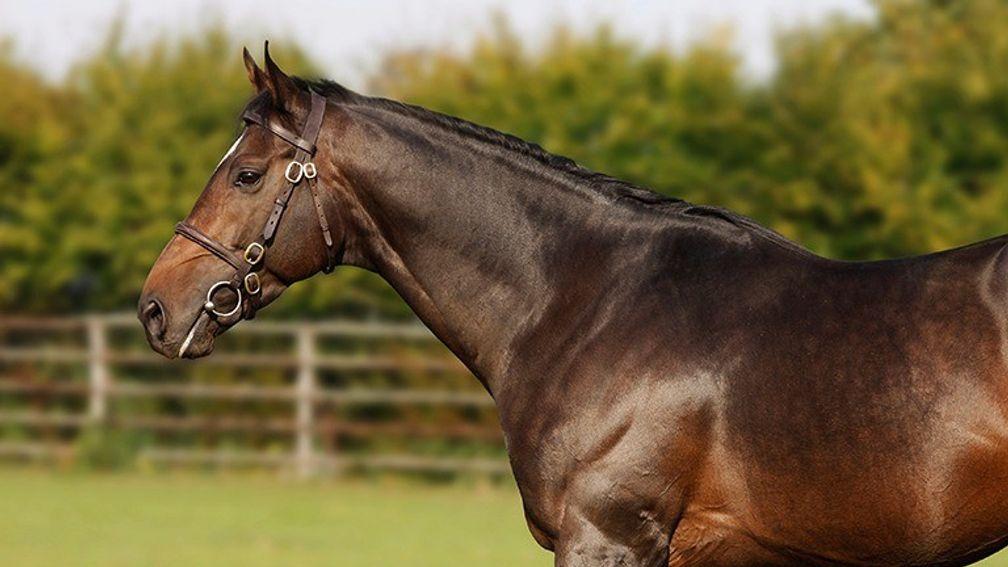'That led to one of the most extraordinary things I've ever seen at a stud farm'
Our intrepid man sees some astonishing sights on his last few days in Germany

Good Morning Bloodstockis Martin Stevens' daily morning email and presented online as a sample.
In the final chapter of Guten Morgen Bloodstock, Martin visits four more studs and sees stallions, mares, youngstock and some unusual methods. Subscribers can get more great insight from Martin every Monday to Friday.
All you need do is click on the link above, sign up and then read at your leisure each weekday morning from 7am.
I’m well aware that no one really likes hearing what other people got up to on their holidays, but this is the final edition of ‘Guten Morgen Bloodstock’ and I promise it contains some fascinating details of the last four studs I saw on my grand tour of Germany.
On Thursday I visited two of the biggest hitters of the German breeding scene, both based near Cologne: Gestüt Röttgen, which bred and owned recent back-to-back Deutsches Derby-winning half-brothers Windstoss and Weltstar, and Gestüt Schlenderhan, which has had more winners of that Classic than any other entity and was home of the mighty Monsun.
Röttgen is an extraordinarily grandiose farm, including a training centre inhabited by Markus Klug, situated surprisingly close to the city on 330 hectares surrounded by a high wall. It was founded by Peter Mülhens, manufacturer of the original ‘eau de Cologne’ in 1924. The family’s silks recall the colours of the iconic bottle of that ‘wunderwasser’ known the world over as 4711.
Upon Peter’s death in 1945 the stud passed to his daughter Maria Mehl-Mülhens, after whom the German 2,000 Guineas is named, and when she died 40 years later it passed into a trust that was set up as the sole inheritor of her entire wealth.
Frank Dorff is the man whose task it is to preserve the wonderful history of the stud, and to ensure it doesn’t become a money pit for the foundation. A local lad whose family had no involvement in horses, he first became interested when admiring the draughts pulling a white wedding carriage through the streets of Cologne and getting to know the driver. A standard German solid education and apprenticeship in stud management followed.
He is clearly doing a good job, as illustrated not only by Windstoss and Weltstar but also by the likes of Preis der Diana heroine Enora and this season’s Italian Derby winner Ardakan. Results this year have been frustrating but full of promise for the future, with Assistent a close fourth in the Deutsches Derby and Wagnis a head second to the cleverly ridden Toskana Belle in the Preis der Diana.
It was Dorff who had the bright idea of trying to get international black type into the stud’s broodmare band, in order to give the stock more global appeal at the sales. To that end, several fillies have been sent to Britain and Ireland to be trained; most famously Wild Coco, who was sent out by Sir Henry Cecil to take the Park Hill Stakes, but also Diadora, who ran second in the Owenstown Stud Stakes for Paddy Twomey earlier this year.
There were three stallions to see at Röttgen – Melbourne Cup hero Protectionist, the well-bred Derby winner Windstoss and a curio fondly regarded by fellow German breeders as ‘Frank’s private hobby’, in Millowitsch.

The nine-year-old is by the rather obscure and short-lived Titus Livius stallion Sehrezad out of the Group 3-placed Fath mare Muriel, a half-sister to Beverly D Stakes runner-up Gifted Girl from the family of Irish Oaks heroine Margarula. He was a BBAG auction race winner at two, and then a prolific stakes scorer in sprints or over a mile every season from three to five.
Dorff reasoned that he was a sound horse with plenty of speed and some precious outcross blood, so why not give him a go? He is either going to end up looking like a Tesio for our times or want to forget about the episode, as the sire (who is perfectly good-looking by the way) has microscopic crops as other breeders are not so convinced by the plan.
Röttgen’s ten-strong draft at next month’s BBAG yearling sale contains three well-bred second-crop colts by Millowitsch – one out of Eloge, a daughter of Galileo and Enora; another who is a half-brother to five black-type horses including Group 2 winner and multiple Group 1-placed Kaspar; and the third out of Group 3 scorer Bützje.
It would be a brave call to say Millowitsch will make it as a stallion in the long run but, either way, I bet his home stud ends up one day breeding some classy horses from his daughters.
Gestüt Schlenderhan, a little further west of Cologne, was founded by Eduard von Oppenheim in 1869 and is therefore Germany’s oldest privately owned stud.
It’s funny how one’s preconceptions can be so wrong, as I had assumed that with its unrivalled success and aristocratic owners – Baronin Karin von Ullmann (née Freiin von Oppenheim) and later her son Baron Georg von Ullmann, in my lifetime – it would be all manicured lawns, fancy-pants fencing and gold filigree gates.
In reality, although the estate has a majestic castle at its heart, it is otherwise an authentic working farm where more care is taken over doing things naturally with the horses than getting the decor right.
I was shown around by Baron Georg’s son Philip von Ullmann, who has some horses in training that carry the yellow and blue silks that were made famous by an uncannily high number of superstars owned by his father, who has moved on to the red and blue Schlenderhan silks since his mother passed away.
They included Group 1 winners Owington, Tiger Hill and Toylsome, but most importantly Monsun. The son of Konigsstühl was bought by Von Ullmann from breeder Gestüt Isarland and later became a game-changing stallion for Schlenderhan and German racing itself.
World champion Manduro, Breeders’ Cup Turf hero Shirocco and the Group 1-winning full-siblings Getaway and Guadalupe are just the cream of the progeny of Monsun raced by Von Ullmann.
There were of course many well-bred youngsters on the farm to see, too many to list, but one easy-to-remember name for the future is Well Well Winston, a good-looking Churchill yearling colt out of Preis der Diana victress Well Timed. A Derby entry is being carefully considered so that he can fulfil his destiny by having his finest hour at Epsom.
One of the most moving moments at Schlenderhan was seeing the stud’s equine graveyard, which contains a veritable who’s who of legends of German racing, from Oleander, Birkhahn and Schwarzgold to Monsun and, sadly all too soon, Adlerflug, a homebred Deutsches Derby winner who had just given the stud another winner of the race in In Swoop and was coming to much greater prominence when he died last year aged 17.

Seeing all those names I asked Philip if he could feel the weight of history on his shoulders, but he didn’t hesitate before replying no, as he knew the success of Schlenderhan was secure because of the expert team, fine facilities and proven quality bloodlines that are in place.
The following day I travelled south to the Frankfurt area for the final two studs of my trip: Gestüt Etzean and Gestüt Karlshof, both relatively new studs compared with Schlenderhan, but both having achieved an awful lot in a short space of time.
Heinz Weil chose 43 hectares of cattle farm located on a plateau that overlooks the picturesque Odenwald forest to lease in order to set up a stud in 1969. Gerhard Kredel, an accomplished rider whose family farmed on the neighbouring property, was later enlisted to manage the growing breeding operation known as Gestüt Etzean.
The stud has since grown to encompass 125 hectares of land, and it is now owned by Heinz’s daughter Christiane Weil-Daßbach and grandson Marc Sonnenburg and run by Gerhard’s son Ralf Kredel, a graduate of the Irish National Stud course.
Neither Weil nor Kredel snr had practical experience of running a stud farm, and so many of the ways of doing things developed at the stud are the result of instinct, research and trial and error, all cut through with a determination to keep the rearing of the horses as natural as possible.
That approach led to one of the most extraordinary things I saw on my German stud trip, and have seen at any farm full stop.
At an early point in the operation's history, before the era of ultrasound scanning, the team were unable to get a mare in foal, so the vet suggested they put her out with the stallion and let nature take its course. She was found to be in foal after four weeks, and was living with the stallion quite happily.
So when Dashing Blade, the multiple Group 1-winning son of Elegant Air, arrived to stand at Etzean in 1992 and was found to be a nervous, intractable individual, he too was given a mare as a companion.
Since then, the stud has introduced a new barren mare to each of its own stallions when she comes in season around February. After the mare is covered she is stabled next door to the stallion, and they are turned out together every day.
So the stud’s newest recruit Japan, the beautifully bred Galileo brother to Mogul and Secret Gesture who himself won the Juddmonte International, has a ‘girlfriend’ this season called Felora, a useful full-sister to the stud’s Preis der Diana winner Feodora by late stallion resident Lord Of England.
I couldn’t help wincing, expecting the worst as I saw the process of Japan and Felora being reunited in their joint-paddock in the morning, but nature knows best. He had a good sniff and teased her, but soon realised she wasn’t in season, and after a spot of nuzzling both just got on quietly with the important business of grazing.
The benefits of the system are manifold. Both Japan and the stud’s other stallion of its own, Amaron, lead happier and less lonely lives and they are also easier to handle as they are impeccably well behaved, showing no signs of 'toxic masculinity'. All of which means the stud doesn’t have to employ a stallion handler.

Former Etzean resident Sholokhov, a useful source of Flat runners but now better known as the source of crack jumpers Don Cossack, Shishkin and Bob Olinger, even had a family once.
Ralf Kredel told me the son of Sadler's Wells had a half-bred nanny mare and her foal as a companion, and although he was attacked by the mare when he tried to approach her on the first day, and was exiled to the other side of the paddock, he was gradually allowed to get closer to the mare and then the foal, and all lived happily together.
The method is, apparently, often the subject of a lot of amused curiosity from other stud managers, but they too believe it when they see it, although Etzean is thought to be still the only major stud that does it, as managers find it hard to convince their owners to have a go.
Etzean’s sympathetic handling proved to be the making of Dashing Blade, and the horse repaid the favour by helping to put the stud on the map.
He sired the top-notchers Faberger, Lord Of England, Noble Pearl, Proudwings and Sirius, and appears in the pedigrees of three of the four Preis der Diana winners bred by the stud in the past 15 years, with Feodora and Palmas both by Lord Of England and Miss Yoda descended from the Dashing Blade mare Monbijou.
The next and final stop on my tour was Gestüt Karlshof, founded in 1990 in an area known as the Tuscany of Germany. It is owned by Bruno and Michaela Faust, and considering that name and the speed at which they achieved success in the breeding shed, you might wonder whether they made a pact with the devil.
In 2000 came a first Deutsches Derby winner in Samum, who scored by five lengths that day, also took the Grosser Preis von Baden and later became a champion sire standing at Karlshof; two years later came a Preis der Diana heroine in Salve Regina, who also finished second in the Deutsches Derby; and four years after that came a second Deutsches Derby scorer in Schiaparelli, who went on to become a multiple Group 1 winner around Europe.
All three were among ten winners out of Sacarina, an Old Vic half-sister to Jersey Stakes runner-up Brave Owen. The exceptional mare, who is the subject of an enormous painting hung in one of the main stud buildings, also produced the dams of Group 1 winners Sea The Moon, Seismos and Sortilege.
In 2008 came a third Deutsches Derby winner in Kamsin, a son of Samum who followed up in the Rheinland-Pokal and Grosser Preis von Baden, where he took the scalp of Adlerflug.

So that’s four Classic winners in less than 20 years, and we haven’t even got on to other Group 1 winners bred by the stud such as A Raving Beauty, Baila Me, Donjah and Khan, or high-class horses like Aolus, Isfahani, La Force and No Limit Credit.
The stud’s current stars are Rubaiyat, a rare thing having once been voted Germany’s horse of the year as a two-year-old, and this season’s Preis der Diana third Mylady and Italian Oaks runner-up Atomic Blonde.
The Fausts have been turning down offers for Mylady, a daughter of The Grey Gatsby who has also won a Group 3 and run second in the German 1,000 Guineas this season. However, they’re not prepared to repeat the experience of A Raving Beauty, who they sold for €230,000 at Arqana after finishing second in the Premio Lydia Tesio, only for her to win two Grade 1s in the US and sell to Japan for €2 million the following year.
This time the plan is to put the value on the filly themselves, and so she is set to run in the EP Taylor Stakes this year.
Another one putting Karlshof’s name in lights at present is the Italian 2,000 Guineas winner See Hector, who hails from the small first crop of the stud’s own shuttle stallion Counterattack.
The sire was a top sprinter in his native Australia by Redoute’s Choice and was secured in a deal struck by Bruno and Michaela Faust’s son Holger, who has quickly become the go-to agent in Germany (and, fun fact, is a joint-owner of this year’s Greyhound Puppy Derby winner Deelish Frankie).
Counterattack has produced a notably high-strike rate of winners, several with black type, and it was interesting to see some in the flesh for the first time as the stud paraded its BBAG-bound yearlings. The ones I saw were really racy types, so I’d be surprised if a few weren’t picked up by pinhookers for the breeze-ups.
Considering the profits made by traders with their yearling purchases in Baden-Baden last year – not least Church Farm and Horse Park Stud’s Cracksman filly related to Feodora bought for €49,000 and resold for €420,000, and Powerstown Stud’s Sea The Moon colt bought for €92,000 and resold for €350,000 – they should be there again in their droves.
And I’m not just saying that because I owe BBAG director Klaus Eulenberger and Deutscher Galopp head Daniel Krüger a debt of gratitude for planning this wonderful week-long trip around Germany’s studs for me.
What do you think?
Share your thoughts with other Good Morning Bloodstock readers by emailing gmb@racingpost.com
Must-read story
“The Arqana August Sale has provided plenty of reasons for optimism,” concludes James Thomas as he dissects the market at the first European yearling sale of the year in Deauville.
Don’t miss ANZ Bloodstock News
Sign up for free to our weekly Asia Bloodstock News publication to receive news and features from all things racing and bloodstock across Mainland China, Japan, Hong Kong, Singapore and beyond.
Make sure to read this week's Asia Bloodstock News
Subscribe for free for the latest bloodstock news from Australia, New Zealand and beyond.

Good Morning Bloodstock is our latest email newsletter. Martin Stevens, a doyen among bloodstock journalists, provides his take and insight on the biggest stories every morning from Monday to Friday
Published on inNews
Last updated
- Breeding right to Blue Point sells for €430,000 on Darley winning bid platform
- Classic hero Metropolitan set for strong home support with Etreham busy at the sales
- 'It has been nothing short of incredible' - Grace Hamilton on Godolphin Flying Start experience
- ‘She’s one of the best two-year-olds in Europe’ - bluebloods set to go down a storm at Arqana Breeding Stock Sale
- HRI announces academy hurdles for unraced three-year-olds starting next season
- Breeding right to Blue Point sells for €430,000 on Darley winning bid platform
- Classic hero Metropolitan set for strong home support with Etreham busy at the sales
- 'It has been nothing short of incredible' - Grace Hamilton on Godolphin Flying Start experience
- ‘She’s one of the best two-year-olds in Europe’ - bluebloods set to go down a storm at Arqana Breeding Stock Sale
- HRI announces academy hurdles for unraced three-year-olds starting next season